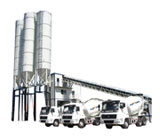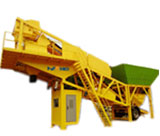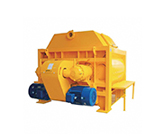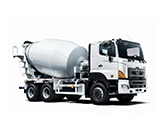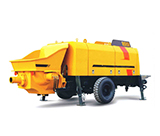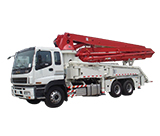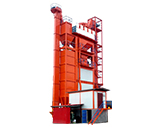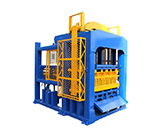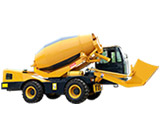Central Mix Concrete Plant
2025.08.06
Central mix concrete plants are specialized production facilities that centrally batch and mix the raw materials required for concrete production (cement, sand, gravel, water, admixtures, etc.) at a fixed site. The resulting concrete is then transported to the construction site after it is finished and meets the quality standards.


Structural Components
A central mix concrete plant is a systematic, integrated system consisting of the following core components:
1. Raw Material Storage System
- Sand and Gravel Silos: These are used to store aggregates such as sand and gravel. They are typically closed or semi-closed silos equipped with level meters to monitor storage levels. Some large concrete batching plants also have aggregate pre-screening equipment to remove impurities.
- Powder Silos (cement silos, fly ash silos, etc.): These are enclosed steel silos that store cement, fly ash, and mineral powder. They are equipped with dust removal devices to prevent dust and arch breakers to prevent clogging. Liquid - Storage Tanks: Store water and admixtures (water reducer, retarder, etc.) and are equipped with level gauges and temperature control devices (in some areas, insulation is required in winter).
2. Batching and Weighing System
- Aggregate Batching: A belt scale or weighing hopper accurately measures the amount of sand and gravel according to the recipe (error is typically ≤±2%).
- Powder Metering: A screw conveyor delivers the powder into the weighing hopper, achieving higher metering accuracy (error is ≤±1%).
- Liquid Metering: A water pump and admixture pump, combined with a flow meter or weighing device, precisely controls the amount of water and admixtures.
3. Mixing System
The core equipment is a concrete mixer (typically a twin-shaft forced mixer). Its high-speed rotating impellers forcefully mix aggregate, powder, and liquid to form a uniform concrete. The mixing time can be adjusted according to the concrete grade (usually 30-90 seconds).
4. Conveying System
- Aggregate Conveying: A belt conveyor transports sand and gravel from the silo to the batching machine.
- Powder Conveying: Powder is conveyed from the silo to the weighing hopper via a screw conveyor (horizontally or vertically).
- Finished Product Conveying: The mixed concrete is loaded into a concrete mixer truck through the discharge port and transported to the construction site.
5. Control System
Based on a PLC (Programmable Logic Controller), coupled with a touch screen or computer interface, it fully automates the batching, mixing, and unloading processes. Multiple concrete recipes can be preset, production data (output, batching accuracy, etc.) can be monitored in real time, and data storage and traceability are supported.
6. Auxiliary Systems
- Dust Removal System: Bag filters are installed at dust-generating points such as the powder silo and mixer to reduce dust pollution.
- Wastewater Recovery System: Wastewater from mixer and truck cleaning is collected and recycled for mixing after sedimentation and filtration (non-potable water).
- Lubrication System: Automatically and regularly lubricates moving parts such as mixer bearings to extend equipment life.
Main features of central mix concrete plant:
- High Production Efficiency:
A single station can produce 50-300 cubic meters per hour (depending on the model), suitable for large-scale, continuous production to meet the concrete needs of large-scale projects.
- Stable Concrete Quality
Utilizing a fully automated metering system, batching accuracy far exceeds that of on-site manual mixing (error can be controlled within ±1%), while ensuring excellent mixing uniformity and ensuring strict adherence to concrete strength, workability, and other indicators.
- High Degree of Automation
Automated control throughout the entire process, from raw material batching to finished product unloading, reduces manual intervention and human error. Production management can also be achieved through a remote monitoring system.
- Environmentally Friendly
Equipped with enclosed silos, dust removal equipment, and a wastewater recovery system, this significantly reduces dust, noise, and wastewater pollution compared to on-site mixing, meeting modern environmental standards.
- Large Initial Investment and High Site Requirements
Requires a fixed site (typically covering several thousand square meters), resulting in high equipment and infrastructure costs. This makes it suitable for long-term, fixed-term production needs.
Scope of Application
Central mix concrete plants are primarily suitable for applications with high concrete volume, high quality requirements, and long construction periods. Typical applications include:
- Large-scale civil engineering projects: highways, bridges, tunnels, and water conservancy projects (such as reservoirs and dams).
- Urban construction projects: high-rise buildings, large residential complexes, municipal plazas, and subways.
- Precast component production: Large-scale production of precast concrete components such as precast panels, pipe piles, and rail sleepers.
In contrast, smaller projects (such as rural self-built houses and minor renovations) are more suitable for mobile concrete batching plants or on-site manual mixing. Central mix concrete plants are the core equipment for large-scale, specialized concrete production.

